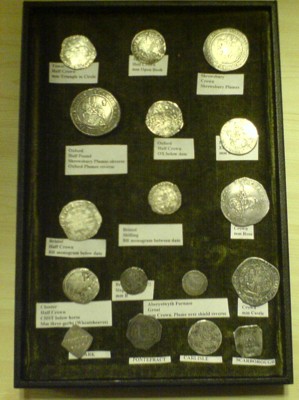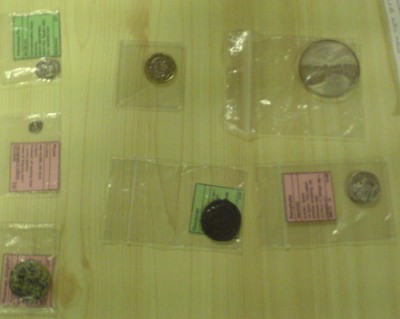 Mick gave a talk on the death of tokens in the UK and Reading’s part in it.
Mick gave a talk on the death of tokens in the UK and Reading’s part in it.January 2008.
Next club meeting Monday 4th February 2007.
We will try to have the lots displayed by 7.l0pm and start the auction just before 8pm in order to be completed by l0pm. Please give the committee members time to put out the lots before charging in!
All members will be given a bid number, you must sign in to be assigned a bid number. Please pick up your paddle bid card prior to the start of the auction.
Finally, while some of the lots have been graded it is still up to prospective purchasers to verify the grading description is to their satisfaction prior to bidding, There will be no returns other than postal lots or coins that are subsequently shown not to be genuine.
Dealer's tables will not be allowed until after the auction and only if time permits.
January meeting.
This meeting was devoted to short talks by members and to award the Mark Myhill memorial shield. Five talks were given.

Tony spoke on “Identification Marks on Coins of the English Civil War”
Many of the mints which were previously recorded – such as Coombe Martin, Appledore etc.. – are now no longer thought to be mint places. Now scholars simply say “mint mark – uncertain mint”.
When Charles fled London, Parliament took over the Royal Mint at Tower Hill and used a triangle in circle mintmark. Charles had already set up a provincial mint in Aberwystwyth using an open book mintmark, run by Thomas Bushell. When war broke out he moved the mint to Shrewsbury, still using the open book but later used plumes as the mintmark. As Charles settled in Oxford he moved Bushell to Oxford and the mintmark changed to a different set of plumes, finally moving to Bristol where a BR was used.Another mintmaster, Sir Richard Vivyan struck coins at Truro (Rose) Exeter (castle or EX) using silver mined in the West Country.
Thomas Carey also ran a number of mints, at Worcester and Hereford. The latter might be the CH (civitas Hereford) mintmark, also SA (Salisbury? or Salopia Roman for Shrewsbury). Coins were also struck at Chester (CHST) mintmark 3 ‘gerbs’ (wheatsheaves) which was the badge of Chester. Mintmark ‘A’ which was thought to be Appledore, is now thought to be Ashby de la Zouche, ‘B’ might be Bridgenorth. When the civil war finished the mines at Aberwystwyth reopened and coins were again struck using the castle mintmark. Siege pieces often have the name of the city on them so present few problems, though many 19th C forgeries exist.
 Mick gave a talk on the death of tokens in the UK and Reading’s part in it.
Mick gave a talk on the death of tokens in the UK and Reading’s part in it.
This was a story of a local man who had a major impact on token coinage. In 1811 there was a bad harvest, food was scarce and expensive and there was a shortage of coinage and few people trusted paper money which was issued in denominations too large to be useful. Consequently there was a surge of tokens issued, both in silver and copper much criticized by the Government of the day, because the silver was considered lightweight, though actually it was generally only lightweight because the value of silver had risen so much.
A Reading businessman and philanthropist J.B. Monck wrote to the prime minister (Percival) and suggested a solution – a gold notional guinea, originally issued at 40 shillings which would then find its true level. Percival was utterly opposed to the private issue of gold tokens and tried to issue a bill preventing the issue of all tokens. However, he was assassinated three days before the final reading. The bill did get a final reading but only after three postponements because silver had risen yet again. Finally the bill was passed but people questioned what would happen then – what would replace the tokens? The Government announced that the bill was not intended to cover copper coins and the floodgates opened again.
Graham talked on what motivated people to collect.
The first difficulty was in choosing a title for this short talk...
But I decided to go with The Search for Value. It had a better sound and somehow went better with my Banking Background.
`The Search for Value.
1. Begins from where we are now.
2. Extracting value takes many forms.
3. The thrill of the chase.
4. Shorten the odds.
I find more to buy by telling myself, `This one is for the lecture collection,' or for `the second collection.' Different themes, expanding the range of subjects to seek out. Things I like. And probably going against what is often recommended - not always buying the best I can afford, but searching for value and buying more coins more regularly.

5. Wants list and interest value.
Objects Lilliputian can now be safely added.
6. Buy what you like.
7. It ends where?
Only you can know where it might lead for you. But you might be tempted to look around in a new way. Enjoy the `Search for Value' and in your own way. For me this short talk ends here.
 Frank gave a talk on “The Coinage of German East Africa”
Frank gave a talk on “The Coinage of German East Africa”
Germany was a latecomer to overseas colonisation and didn’t start until the late 19th century. Companies were set up to promote foreign trade and colonies one of which was the German East Africa Company. They made treaties with various tribes and chiefs on the East African coast starting in 1884 and by 1897 controlled an area a little smaller than France and Germany combined. The main coinage was Indian Rupees made up of 64 Paisa and they struck a DOA Rupee with a flamboyant portrait of Kaiser Wilhelm on the Obverse and the traditional symbols of Africa (Palm tree with Lion under) on the reverse, and 1 pesa coins in copper. Denominations of the Rupee were 2, 1, ½ , and ¼ .
A story has it that the Kaiser (Queen Victoria’s grandson) complained that he lacked a snow covered mountain in his territories so the Queen arranged for the Government to move the border so that Mount Kilimanjaro was included in DOA.
In 1903 the German Government took over the administration from the DOA government and changed the Rupee to a decimal system of 100 Hellers to 1 Rupee. They still struck the 1, ½ , and ¼ Rupee ( no 2 Rupee) but also struck ½ , 1, 2 and 5 Heller in copper. Later they introduced a 5 Heller and 10 Heller in cupronickel with a hole in the centre.
In 1914 war broke out in Europe. In the colonies there was a tacit agreement between the Governors of British and German East Africa not to be too belligerent and to try to continue exploiting their respective colonies. However, the German commander Paul von Lettow Vorbeck would have none of this and decided that although he had few resources and Britain’s mastery of the seas would prevent him getting regular supplies he would be as mobile and aggressive as possible so as to tie up as many British troops as he could to prevent them from taking part in the European war. In this he was completely successful. While not giving details of every campaign Frank pointed out that for four years with an army of 4-5,000 he tied up at least three times that number of British troops. He inflicted two major defeats on the British and when finally cornered on the Portuguese/Africa border simply crossed into Portuguese Africa from where the Briitsh were reluctant to follow him and continued to harry our forces until the end of the war. As he was still undefeated at the end of the war he was given very favourable terms to induce him to surrender. All officers were allowed to keep their arms and the native Askaris were allowed to return home.
The numismatic interest to us is that during the course of his campaigns he soon ran short of coinage and notes to pay his troops and fund his war (war is a very expensive business) so in 1916 he set up an emergency mint at Tabora using an old steam engine. Here he produced copper or brass 5 Hellers, 20 Hellers the famous gold 15 rupee and a multitude of emergency notes. The emergency notes began as early as March 1915 and comprised 1, 5, 10, 20, 50 and 200 Rupee notes. The Germans called them interim banknotes because they were supposed to be redeemed after the war. We don’t know whether they were – but the suspicion is that they were not as evidenced by the large numbers of them that exist today. It was not really in the interests of the ‘winners’ to redeem the notes and the Germans were not in a position to do so. We call them ‘Bush notes’ because they circulated essentially in the ‘bush’ by the German forces and were used to pay for their necessities. So ended a short lived but numismatically interesting episode in Germano-British history.
The standard of all four talks was very high and much appreciated. A vote was taken Tony Martin’s talk won by a landslide! He was duly awarded the Marc Myhill memorial shield.
The answers to Gavin's quiz are given below.
Numismatic Quiz
Jamaican Coins For Sale
If anyone is interested in some UNC Jamaican 1c coins from 1969-73 (2-300 of each) please contact Michael Isaacs at Reading university or e-mail on sisisacs@rdg.ac.uk.
Future Events.
Spink, 69, Southampton Row, Tokens 24th January
London Coin Fair, Holiday Inn, Bloomsbury – 9th February
Birmingham Coin Fair - National Motorcycle museum, 10th February
Past Events
In January 1978 members heard a talk by Graham Kirby on "Numismatic Miscellany".
In January 1988 Michael Fulford talked on "A Clergyman's Collection of Roman Coins".
In 1998 the January meeting was Short Talks by Members